June 23: Willi Klinger and his team at the Austrian Wine Marketing Board recently organised a trip for select journalists, sommeliers and importers, that was near perfect and if rated on the Parker scale, deserved 100 points for planning, execution and fun, writes Subhash Arora who felt it was a model worth emulating by other countries making similar promotional efforts.
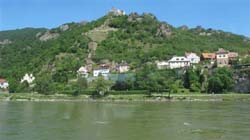 The total of about 175 persons were divided into three groups to cover all the wine producing regions- the German speaking invitees were grouped together for the trip to Styria in the South while NiederÖsterreich (Lower Austria) and Burgenland were options given to those who had been to Austria earlier. A group of rookies was taken on a whirlwind tour of different parts-all of them converging in Wien (Vienna)- the capital and also fourth wine region, on the last day when they could meet each other and let their hair down for a last hurrah before going home with a long, complex and pleasant after-taste of the trip. The total of about 175 persons were divided into three groups to cover all the wine producing regions- the German speaking invitees were grouped together for the trip to Styria in the South while NiederÖsterreich (Lower Austria) and Burgenland were options given to those who had been to Austria earlier. A group of rookies was taken on a whirlwind tour of different parts-all of them converging in Wien (Vienna)- the capital and also fourth wine region, on the last day when they could meet each other and let their hair down for a last hurrah before going home with a long, complex and pleasant after-taste of the trip.
The structure of the programme was perfect. After the traditional evening of fun at the Rotes Haus in Nussberg, the first group moved north towards Retz, a small town in the Weinviertel area close to the Czech border. As one discovered along the way, the other regions of Lower Austria-Kamptal, Kremstal (tal means valley), Wachau, Traisental and Wagram would also be a part of the 3-day journey-from 29-31 May. Two other regions, Carnuntum and Thermenregion, were not included in the visit.
Plan of Action (POA)
AWMB had distributed the complete set of literature and background catalogues and pamphlets that one would require to familiarise for the whole trip including the history, DAC laws, and specifics of the zones. In fact, the handy guide ‘Austrian Wine in Depth’ gives complete information about Austrian wines. For more details, the specifics, latest statistics, specialty of each region etc were also handed out in advance.
But what was most comprehensive and became the ‘Bible’ for every visitor was the handy Tasting Notes booklet which was a brilliant idea with all the necessary details including the Programme, Maps, Routes, Wines to be tasted and even the food and wine Menu at various stops on the way.
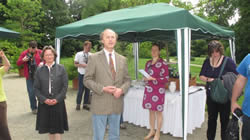 For instance, when we visited Gasthaus Martin Weiler in Schloss Mühlbach in Weinviertel for Schnitzel Cookery Demo on Day 1, we knew the Menu for lunch as well as the twelve Weinviertel DAC wines for tasting and two sweet wines with general appellation-NiederÖsterreich. The three ladies, Susanne Staggl and Barbara Arbeithuber- marketing managers of AWMB - and Ulrike Hager were already dressed in dirndls (their ethnic, traditional outfit) to demonstrate the cooking under the stewardship of Chef Weiler, to make it fun and interesting. For instance, when we visited Gasthaus Martin Weiler in Schloss Mühlbach in Weinviertel for Schnitzel Cookery Demo on Day 1, we knew the Menu for lunch as well as the twelve Weinviertel DAC wines for tasting and two sweet wines with general appellation-NiederÖsterreich. The three ladies, Susanne Staggl and Barbara Arbeithuber- marketing managers of AWMB - and Ulrike Hager were already dressed in dirndls (their ethnic, traditional outfit) to demonstrate the cooking under the stewardship of Chef Weiler, to make it fun and interesting.
Weinviertel DAC
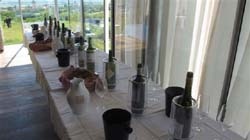 ‘Weinviertel is the first region to have obtained the DAC (Districtus Austriae Controllatus) status in 2003. Started in 2001, the official designation displays regional typicity and origin,’ explained Susanne Staggl giving a brief history of Austrian wines before handing over to Ulrike Hager, head of the Regional Wine Committee, who gave a slide presentation about the biggest vine growing region with 13,356 hA in Lower Austria which has 27,128 hA of grapes. ‘Weinviertel is the first region to have obtained the DAC (Districtus Austriae Controllatus) status in 2003. Started in 2001, the official designation displays regional typicity and origin,’ explained Susanne Staggl giving a brief history of Austrian wines before handing over to Ulrike Hager, head of the Regional Wine Committee, who gave a slide presentation about the biggest vine growing region with 13,356 hA in Lower Austria which has 27,128 hA of grapes.
About half of this region produces Grüner ( ü pronounced like in crew) Veltliner (velt-lean-er), more easily pronounced as (Gru-Vee). The fruity wine has many styles- it can be dry to very sweet, including sparkling and can be made to drink young or age for decades. The additional feature-a requirement in this region - that it must be spicy in flavour, would make it a favourite possibility for the Indian palates.
All the information was included in the kit provided to the participants. All they were to do was listen to her and taste 12 wines-Gru-Vee all, with one being a Reserve. Our Bible, the booklet already given by AWMB with total information on our itinerary including these wines with complete details about vintage, style, alcohol content (very important but seldom given), residual sugar (great fun to guess the feeling on the palate and then compare with the actual figures) and the ex-cellar Price. This ‘Bible’- The Many Faces of Niederösterreich-Lower Austria, added to what is usually the ‘WOW’ factor in a usual blind Wine Tasting and earned Team Klinger 10/10.
The Schnitzel Cooking and Wine Bar were organised at a beautiful, old Schloss (castle) Mühlbach with enchanting lawns in the front of the restaurant where several budding chefs in the group tried their hand at pounding the veal escalope already chopped into pieces, sprinkling sea salt on both sides, dipping in the already beaten eggs followed by breadcrumbs and then frying in the simmering lard.
While waiting for the Schnitzel cookery lessons, one could taste twelve more Weinviertel Grüner Veltliners conforming to the DAC regulations. The two sweet wines- a GV Eiswein (Ice-wine) and a TBA (TrockenBeerenAuslese) GV were designated as Niederösterreich according to the rules.
Kamptal DAC
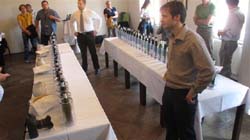 After a quick walk-through past the Loisium (an interesting wine museum I had enjoyed visiting twice earlier) cellar, which was rather gimmicky but fun for wine novices and tourists, we were lead by Willi’s team to two rooms-one each for tasting 26 Kamptal DAC Gru-Vee and 26 Rieslings. Unlike Weinviertel DAC, this appellation allows use of either of the two varietals. After a quick walk-through past the Loisium (an interesting wine museum I had enjoyed visiting twice earlier) cellar, which was rather gimmicky but fun for wine novices and tourists, we were lead by Willi’s team to two rooms-one each for tasting 26 Kamptal DAC Gru-Vee and 26 Rieslings. Unlike Weinviertel DAC, this appellation allows use of either of the two varietals.
This relatively small region with only 3,802 hA of plantation is known for Loess (combination of sand, limestone and clay). The terraced vineyards produce some of the highly mineral and powerful Rieslings a majority of which I found too sharp in acidity for the Indian palate, especially those with less than 3 gm of residual sugar- most Europeans love this style. I found wines with 6-8 gm sugar singing on my palate and felt like a better match with spicy Indian food.
Visiting Weingut Hiedler
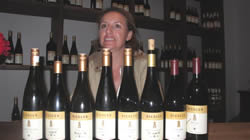 Team Klinger had meticulously planned for 2-3 participants each to visit a producer to show them the winery, vineyards and organise the dinner with them. I had the privilege of visiting a quality producer, a family winery owned by a German, Ludwig Hiedler. and Frau Maria Hiedler, a Spanish woman from Barcelona-as bubbly and vivacious as fine Cava. There is a beautiful panorama of the region from the terrace of their residence-cum-winery, including the serene and high quality yielding vineyards yonder- Heiligenstein and Gaisberg though the grapes for more pedestrian wines come from Spiegel vineyards we drove by later with her. The Hiedlers have expanded the winery by buying out the property around theirs over the years. Team Klinger had meticulously planned for 2-3 participants each to visit a producer to show them the winery, vineyards and organise the dinner with them. I had the privilege of visiting a quality producer, a family winery owned by a German, Ludwig Hiedler. and Frau Maria Hiedler, a Spanish woman from Barcelona-as bubbly and vivacious as fine Cava. There is a beautiful panorama of the region from the terrace of their residence-cum-winery, including the serene and high quality yielding vineyards yonder- Heiligenstein and Gaisberg though the grapes for more pedestrian wines come from Spiegel vineyards we drove by later with her. The Hiedlers have expanded the winery by buying out the property around theirs over the years.
After the visit to the small winery in the basement, Maria took out 8 bottles of our choice for tasting. She honoured us by opening cartons of Zalto glasses, the feminine and elegant new wave glasses that may not be safe machine-washable or in restaurants but at €30 a piece (the price at Loisium) they are fabulous for special occasions. They offer a more elegant, feminine and delicate alternative to the iconic Riedel, also made in Austria.
 The dinner that followed at the Heurigenhof Bründlmayer was also a smart way to have the guests sample 20 wines from 4 wineries- Bründlmayer, Hiedler, Nestl and Loimer-all four high quality producers; not counting a Rosé Brut from Willi Bründlmayer, the owner who presented the wines and food from his heurigen (originally a Viennese concept of an inn where a traveller could stop by for a glass of wine from the producer and eat out of a limited Menu of locally grown generally cold food). The dinner that followed at the Heurigenhof Bründlmayer was also a smart way to have the guests sample 20 wines from 4 wineries- Bründlmayer, Hiedler, Nestl and Loimer-all four high quality producers; not counting a Rosé Brut from Willi Bründlmayer, the owner who presented the wines and food from his heurigen (originally a Viennese concept of an inn where a traveller could stop by for a glass of wine from the producer and eat out of a limited Menu of locally grown generally cold food).
The food quality and presentation were immaculate perhaps due to the presence of the boss. Nevertheless, decent quality at fair prices appeared to be the hallmark for a casual visitor. As Willi put it, there was not much income from the heurigen but it provided an opportunity for the costumer to taste his wines.
Day 2
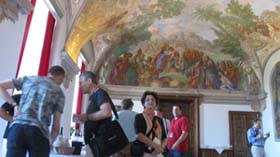 Back at Hotel Loisium where one had barely enough sleep, Team Klinger had organised yoga and morning workouts for those who had been drinking a lot of wine besides tasting. On the dot, the group left for Stift Göttweig, a 900-year old monastery near Krems producing Kremstal DAC wines. The winery at the Abbey is owned by Fritz Miesbauer who had hosted the tasting a couple of years ago too. But the place is so absorbing that it took a while enjoying the view of Kamptal, Krems, Wachau and a part of Wagram from the terrace before moving inside, appreciating the Abbey, tasting 18 GV and Rieslings from the grapes grown in the 2196 hA Kremstal DAC and the tiniest, 790 hA Traisental DAC . Back at Hotel Loisium where one had barely enough sleep, Team Klinger had organised yoga and morning workouts for those who had been drinking a lot of wine besides tasting. On the dot, the group left for Stift Göttweig, a 900-year old monastery near Krems producing Kremstal DAC wines. The winery at the Abbey is owned by Fritz Miesbauer who had hosted the tasting a couple of years ago too. But the place is so absorbing that it took a while enjoying the view of Kamptal, Krems, Wachau and a part of Wagram from the terrace before moving inside, appreciating the Abbey, tasting 18 GV and Rieslings from the grapes grown in the 2196 hA Kremstal DAC and the tiniest, 790 hA Traisental DAC .
Team Klinger did not miss the opportunity to request divine blessings for the group. ‘May the Word of God be your guide throughout your life and His mercy always be with you,’ read the ‘Bible.’ The Abbey is a highly recommended destination if you visit Austria-even if you never tasted a Grüner Veltliner before or cannot pronounce it properly yet.
Tasting Organic Wines
Austria strongly supports sustainable form of viticulture- organic and biodynamic are the buzz words. What better way to taste such wines than at a farm on top of a small hill with a panoramic view! Nikolaihof is a biodynamic farm with a 2000-year history, being run by Christine and Nikolai Saahs since 1971. Their wines carry the certification of ‘demeter’- the only genuine biodynamic certification, she says. A few producers claiming to be biodynamic did show their disagreement at times.
Another such producer is Niki Moser, grandson of the legendry Lens Moser who introduced new trellis system and viticulture techniques for GV in 1950. He had revolutionised the making of Grüner Veltliner, catapulting them to a level bringing them into the global limelight. Moser believes that within 10-15 years, Austrian wine makers would not have any other choice but to go with bio-dynamic grape farming in order to sustain the soil. A small producer, he conceded that the average consumer did not care how the wine is made but was concerned only with the quality, taste and price.
There were 20 wines from organic vineyards from all the regions we visited. Nikolaihof GV Weingebirge Smaragd Wachau (which has three classifications of white wines depending upon the alcohol level- Steinfeder, Federspiel and Smaragd-less than 11.5%, up to 12.5% and 12.5% and more for dry and powerful) scored highest (94) in my Notes. Others that impressed as outstanding were Sepp Moser GV Gebling Kremstal dac ‘10 (92), Veyder-Malberg GV Hochran Wachau ‘10 (92), Zilinger Johannes Riesling Heisthal Weinviertel dac ‘09 (92) and Nikolaihof Riesling Klausberg Wachau ‘06 (93).
Boat Ride on the Danube
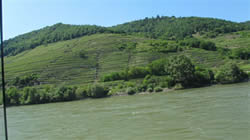 No wine lover would disagree that a picnic lunch followed by a boat ride on the Danube with sexy vineyards for company along side, was a perfect way of spending a spring afternoon in Wachau. This is exactly what the AWMB had in store, but also with six GV wines from Wachau on the boat presented by a winemaker of Domaine Wachau who also directed us to various historic vineyards that came our way from Spitz to Dürnstein. No wine lover would disagree that a picnic lunch followed by a boat ride on the Danube with sexy vineyards for company along side, was a perfect way of spending a spring afternoon in Wachau. This is exactly what the AWMB had in store, but also with six GV wines from Wachau on the boat presented by a winemaker of Domaine Wachau who also directed us to various historic vineyards that came our way from Spitz to Dürnstein.
Tri-Nation Rieslings
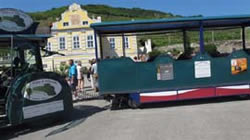 Ask an Austrian, German or an Alsatian and he will have a different opinion about his Rieslings- his being the best. Klinger’s team organised a tasting seminar at Domaine Wachau- a Baroque Cellar in Castle Dürnstein. To add to the festive mood, the wine folks were transported in a touristic toy train through the small town, giving them numerous clicking opportunities before reaching the Castle where Romano Horvath MW, Managing Director of Domaine Wachau welcomed them. Caro-Maurer, the German hopeful for MW this July had come specially to add a German flavour to the seminar. Ask an Austrian, German or an Alsatian and he will have a different opinion about his Rieslings- his being the best. Klinger’s team organised a tasting seminar at Domaine Wachau- a Baroque Cellar in Castle Dürnstein. To add to the festive mood, the wine folks were transported in a touristic toy train through the small town, giving them numerous clicking opportunities before reaching the Castle where Romano Horvath MW, Managing Director of Domaine Wachau welcomed them. Caro-Maurer, the German hopeful for MW this July had come specially to add a German flavour to the seminar.
Four flights of four wines each had been organised. Starting with Wachau, Germany (Rheingau, Nahe, Rheinhessen and Pfalz were selected), Alsace and ending with generic Austria (Wachau, Kremstal dac, Kamptal dac and Traisental dac were featured). General consensus was that German wines were lighter in style and were fine and delicate while Austrian wines were more robust and depended on structure.
Comparisons and contrasts and the perennial debate on personal choice notwithstanding, the wines were generally delicious and good quality and one would love to drink them with proper food match, at any time.
Gourmet Dinner with Danube Wines
Carrying a perfect day into a perfect dinner does not always work but Team Klinger had well selected the best restaurant that Lower Austria has to offer, with dinner at Landhaus Bacher, the holder of two Gault Millau Chef of the Year Awards for Lisl-Wagner Bacher (1983) and her son-in-law Thomas Dorfer (2009). Located near Krems, the restaurant is a part of a boutique hotel and has an excellent cellar. But this evening there would be wines from Lower Austria for the 4-course dinner including a Pinot Noir and Bordeaux-blend red Niederösterreich wines to match the excellently cooked Glazed Roebuck in the main course. Eiswein 2008 from Türk with 176 gm of residual sugar but excellent acid balance, made it a heavenly match with the Cream Soufflé with condiments.
Day 3
Lest the participants go home with the impression that Lower Austria makes only GV or Riesling (out of 27,130 hA planted, 11,873 hA are dedicated to the star grape Gru-Vee but only 1,538 hA cultivate Riesling) or mostly white wine (6817 hA vineyards focus on red wine also-25% of total plantings), there was a tasting of ‘other varietals’ in the morning at the Loisium Hotel.
Tasting of ‘other’ Varietals
Willi had taken it upon himself to guide the tasting of the ‘other’ grapes with a 3-flight tasting totalling 12 wines and an additional tasting of a couple of dessert wines. Weiβburgunder (also written as Weissburgunder which is Pinot Blanc), Chardonnay, Neuburger, Roter Veltliner (a white variety with a tinge of red on the skin, having no relationship with GV) led the Flight 1.
Rotgipfler (an obscure white variety grown in 100 hA only), Zierfandler, Sauvignon Blanc (king grape of Steyer) and Müller Thurgau were in the next flight. Pinot Noir, Zweigelt, St. Laurent and a red Cuvee in the last flight were technically well made red wines but failed to impress me, perhaps as the whites had already made an impact with their quality and diversity.
Flying Visit to Wagram
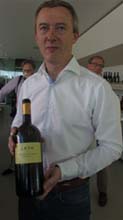 Veritas is a new enoteca in the town of Kirchberg in Wagram, the loess - rich small wine region with 2451 hA concentrating on Grüner and Roter Veltliner. This venue also offered a flying lunch with savoury snacks- the shrimp and cold sliced cucumber and small minced veal mini burgers resting on seasoned mashed potatoes, being the top favourites out of eight items of ‘tapas’ the Menu, for which had also been already printed in the ‘Bible’ Veritas is a new enoteca in the town of Kirchberg in Wagram, the loess - rich small wine region with 2451 hA concentrating on Grüner and Roter Veltliner. This venue also offered a flying lunch with savoury snacks- the shrimp and cold sliced cucumber and small minced veal mini burgers resting on seasoned mashed potatoes, being the top favourites out of eight items of ‘tapas’ the Menu, for which had also been already printed in the ‘Bible’
Before the quick lunch in the open area outside the enoteca under the beautiful, shining and welcome sun, a flight of 16 Grüner and 2 Roter welcomed the visitors with Franz Leth, Owner of Weingut Leth holding fort on behalf of the Wagram producers. Anton Bauer GV Grande Reserve (93) and the Leth Scheiben 2007 (magnum-with 14% alc.) impressed the most while Familie Paschinger, Fritz Solomon, Reinberger, Ott, Ecker-Eckhof and Grill were very good. (90)
Klosterneuburg Monastery
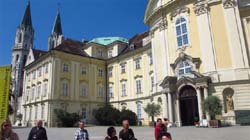 One of the few monasteries where wine production still exists is Stift Klosterneuburg. It is still home to a religious faith with monks living in the monastery which was once an imperial residence, stores priceless artistic treasures and is a must-see place for visitors to Vienna. Over the centuries, monks have been producing wines in several monasteries but if one were looking for a monk running the winery, one would be disappointed. The winery is being run professionally by a team led by Wolfgang Hamm as the Managing Director who took us through a guided tour of the historical winery which has been suitably spruced up and welcomes around 100,000 visitors including non wine drinkers. The GV and Riesling from Hengsberg and Franzhauser vineyards were outstanding. One of the few monasteries where wine production still exists is Stift Klosterneuburg. It is still home to a religious faith with monks living in the monastery which was once an imperial residence, stores priceless artistic treasures and is a must-see place for visitors to Vienna. Over the centuries, monks have been producing wines in several monasteries but if one were looking for a monk running the winery, one would be disappointed. The winery is being run professionally by a team led by Wolfgang Hamm as the Managing Director who took us through a guided tour of the historical winery which has been suitably spruced up and welcomes around 100,000 visitors including non wine drinkers. The GV and Riesling from Hengsberg and Franzhauser vineyards were outstanding.
The monastery owns 106 hA of vines and produces about 75,000 cases of wines annually. It claims to be the first and only net carbon footprint free winery in Europe. The ‘oldest’ viticulture university was also founded here in 1860. The enormous size can be gauged from the fact that the roofs of the buildings, including the winery, occupy 6 hA of space. Being very close to the Danube, the winery has a microclimate that is influenced by the river. The prices are reasonable, so when you buy a bottle of wine from the Abbey, you are not only helping yourself; you are also helping to support the maintenance of the Abbey.
The Grand Finale
Those visitors who felt that there had not been enough tasting to merit their time, a Big Austrian Party –the Grand Finale, had been organised. Apart from sumptuous food, great music and a special performance by Willi the Kling, one could taste about 90 wines. The party where many new friendships made during the trip were sealed and old ones renewed, was the final judgment of Team Klinger- and it came out with flying colours, scoring a perfect 100.
Branding
 Branding of Austrian Wine was perhaps a key to the success of the programme and at every tasting event one noticed the presence of the Austrian Wine logo with the round Banderole of Red White and Red seen on all the Qualitätswein (Quality wines) -sometimes even the wineries sported the logo- a point that ought to be of key significance to the producers in India and perhaps the Indian Grape Processing Board whose biggest responsibility besides getting the proper wine laws in order is of prime importance. Branding of Austrian Wine was perhaps a key to the success of the programme and at every tasting event one noticed the presence of the Austrian Wine logo with the round Banderole of Red White and Red seen on all the Qualitätswein (Quality wines) -sometimes even the wineries sported the logo- a point that ought to be of key significance to the producers in India and perhaps the Indian Grape Processing Board whose biggest responsibility besides getting the proper wine laws in order is of prime importance.
Willi Klinger is also a Brand unto himself. It was interesting to see an organisation of 20 people galvanise the whole industry in the effort to promote Austrian wine. It was interesting to see about 15 of the 20 on the road, in every coach with a car to spare at each location so the Marketing Managers and other personnel could interact with the visitors and network.
Producers are also as affectionate as they are appreciative, of his efforts. Several of them confided in private that he was full of energy and enthusiasm and always came up with new ideas. If last year, the gala dinner where all the invitees meet on the last evening , was at The Schönbrunn Palace Garden Gloriette a couple of years ago, he chose a private banquet room at the Prater- a popular Viennese amusement park this time. The versatile Willi enthralled the participants with ‘Roll over Beethoven’ on the piano, this time he was crooning away ‘Let it Be’ on the keyboard!
For some of the earlier articles, visit
Austrian Wine : Understanding Austrian Wines
Austrian Wine : Vines Full of Knots and Crosses
Austrian Wine : Give me the Green Please
Subhash Arora
Tags: Austria, Lowe Austria, Austrian Wine, Weinviertel, Wachau, Wagram, Kamptal, Kremstal, Traisental, Wien, Vienna, organic, Willi, Klinger, Loisium, Grüner Veltliner, Gru-Vee, GV, Riesling
|